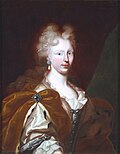Landgravine Elisabeth Amalie of Hesse-Darmstadt
Electress Palatine From Wikipedia, the free encyclopedia
Landgravine Elisabeth Amalie Magdalene of Hesse-Darmstadt (20 March 1635 – 4 August 1709) was a German princess of Hesse-Darmstadt who became Electress Palatine as the second wife of Philip William, Elector Palatine.
This article includes a list of references, related reading, or external links, but its sources remain unclear because it lacks inline citations. (June 2024) |
| Elisabeth Amalie of Hesse-Darmstadt | |||||
|---|---|---|---|---|---|
 | |||||
| Electress Palatine | |||||
| Tenure | 26 May 1685 – 2 September 1690 | ||||
| Born | 20 March 1635 New Palace, Gießen, Germany | ||||
| Died | 4 August 1709 (aged 74) Neuburg Palace, | ||||
| Burial | Neuburg an der Donau, Germany | ||||
| Spouse | |||||
| Issue Detail | Eleonor Magdalene, Holy Roman Empress John William, Elector Palatine Wolfgang George Frederick von Pfalz-Neuburg Ludwig Anton von Pfalz-Neuburg Charles III Philip, Elector Palatine Alexander Sigismund, Bishop of Augsburg Francis Louis, Archbishop of Trier Frederick Wilhelm von Pfalz-Neuburg Maria Sophia, Queen of Portugal Maria Anna, Queen of Spain Philip William August of Neuburg Dorothea Sophie, Duchess of Parma Hedwig Elisabeth, Princess Sobieski Countess Palatine Leopoldine Eleonora of Neuburg | ||||
| |||||
| House | Hesse-Darmstadt | ||||
| Father | George II, Landgrave of Hesse-Darmstadt | ||||
| Mother | Sophia Eleonore of Saxony | ||||
| Religion | Roman Catholicism prev. Lutheranism | ||||
Biography
Summarize
Perspective

Born at the New Palace in Gießen, Elisabeth Amalie was the daughter of George II, Landgrave of Hesse-Darmstadt and Sophia Eleonore of Saxony. Her siblings included Louis of Hesse-Darmstadt, future Landgrave of Hesse-Darmstadt and Anna Sophia, Abbess of Quedlinburg.
Elisabeth Amalie was brought up strictly by her mother, who was a devout Lutheran. She had an attractive appearance with striking blond hair, a trait she kept until her old age and which was inherited by her daughters Eleonor Magdalene and Dorothea Sophie, the latter being known in particular for her blonde hair.
On 3 September 1653 she was married at Langenschwalbach to Count palatine Philip William of Neuburg, who later became Prince-elector of the Palatinate. Her husband was some twenty years older than her and was the heir to the Electoral Palatinate, which was one of the most important states within the Holy Roman Empire. In the course of her marriage, Elisabeth Amalie was pregnant 23 times in just 24 years.
She converted to Catholicism on 1 November 1653 in the presence of the elector and archbishop of Cologne, Maximilian Henry of Bavaria.
The writer William Nakatenus dedicated his work The Heavenly Palm little garden to her.
Issue
Summarize
Perspective
She gave birth to nine sons and eight daughters, 14 of whom lived to adulthood.
| Issue | ||||||||||||||||||||||||||||||||||||||||||||||||||||||||||||||||||||||||
|---|---|---|---|---|---|---|---|---|---|---|---|---|---|---|---|---|---|---|---|---|---|---|---|---|---|---|---|---|---|---|---|---|---|---|---|---|---|---|---|---|---|---|---|---|---|---|---|---|---|---|---|---|---|---|---|---|---|---|---|---|---|---|---|---|---|---|---|---|---|---|---|---|
|
Elisabeth Amalie also suffered six miscarriages:
- A miscarried daughter (16 January 1654)
- A miscarried daughter (28 October 1660)
- A miscarried son (1 February 1662)
- A miscarried daughter (18 July 1671)
- A miscarried daughter (28 October 1676)
- A miscarried son (1 February 1678)
References
- Choker, Peter, Diseases of the kings of Spain: the Austrians. From Madness to impotence Joan of Charles II the Bewitched (Madrid: The Sphere Books Ltd., 2005).
External links
- Landeshauptstadt Düsseldorf - Elisabeth Amalie Magdalena (1635 - 1709), Landgräfin von Hessen-Darmstadt, Pfalzgräfin bei Rhein zu Neuburg, Herzogin von Jülich-Berg, seit 1685 Kurfürstin von der Pfalz
- Kulturgeschichte der Stadt Schwalbach, p. 39, at Google Books
- Annalen des Historischen Vereins für den Niederrhein, insbesondere die alte Erzdiözese Köln, p. 237, at Google Books
Wikiwand - on
Seamless Wikipedia browsing. On steroids.














